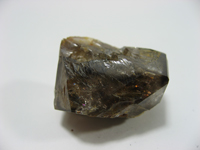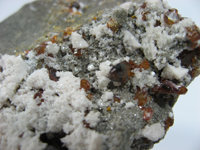![]()
Topaz is a silicate based mineral made up mostly of silicon and fluorine. The name topaz was historically used to describe any type of yellow gemstone. However, in modern times the name topaz denotes on the silicate based mineral described in this article. The name "topaz" is derived (via Old French: Topace and Latin: Topazus) from the Greek Τοπάζιος (Τοpáziοs) or Τοπάζιον (Τοpáziοn.) Τοpáziοn is the ancient name of St. John's Island located in the Red Sea which was difficult to find. A yellow stone (now believed to be chrysolite) was mined in ancient times from the island. The actual mineral topaz was not really well known before the classical era. The word topaz may also have roots in the Arabic word توباز which meant "the subject of the search" or the Sanskrit word तपस् "tapas" meaning "heat" or "fire.
![]()
Within the metaphysical realm of minerals, Topaz soothes, heals, stimulates, recharges, re motivates and aligns the meridians of the body – directing energy to where it is needed most. It promotes truth and forgiveness. Topaz brings joy, generosity, abundance and good health. It is known as a stone of love and good fortune. Releases tension, inducing relaxation. Topaz promotes openness and honesty, self-realisation and self-control. It aids problem-solving and assists in expressing ideas and stabilizes emotions, making the believer receptive to love from all sources.
Please note that MIROFOSS does not suggest in any way that minerals should be used in place of proper medical and psychological care. This information is provided here as a reference only.
![]() Topaz is generally used as a gemstone for jewelry. Topaz is also a reference species on the Mohs Hardness scale (8.0)
Topaz is generally used as a gemstone for jewelry. Topaz is also a reference species on the Mohs Hardness scale (8.0)
![]()
Topaz can usually be found in pegmatites and high temperature quartz veins. Topaz can also be found in cavities in granites and rhyolites and can be deposited by fluorine-rich vapors in rocks of rhyolite composition.
![]()
Topaz is commonly associated with silicic igneous rocks of the granite and rhyolite type. It typically crystallizes in granitic pegmatites or in vapor cavities in rhyolite lava flows like those at Topaz Mountain in Western Utah. It can be found with fluorite and cassiterite in various areas including the Ural and Ilmen mountains of Russia, in Afghanistan, Sri Lanka, Czech Republic, Germany, Norway, Pakistan, Italy, Sweden, Japan, Brazil, Mexico, Flinders Island, Australia, Nigeria and the United States. Some clear topaz crystals from Brazilian pegmatites can reach boulder size and weigh hundreds of pounds. Crystals of this size may be seen in museum collections. The Topaz of Aurungzebe, observed by Jean Baptiste Tavernier measured 157.75 carats. The American Golden Topaz, a more recent gem, measured a massive 22,892.5 carats.
Other than in the basic mineral form, topaz can be found in two distinct varieties:
![]()
| Cleavage | Perfect | |
| Colour(s) | Colourless, Pale blue, Yellow, Yellowish brown, Red | |
| Specific Gravity | 3.55 | |
| Diaphaneity | Transparent | |
| Fracture | Brittle - Uneven - Very brittle fracture producing uneven fragments | |
| Mohs Hardness | 8.0 | |
| Luminescence | Fluorescent, Short UV - golden yellow, Long UV - cream | |
| Lustre | Vitreous | |
| Streak | White | |
| Habit(s) | Crystalline to Massive to Prismatic | |
| Radioactivity | Non-radioactive | |
| Magnetism | Non-magnetic | |
| Electrical | Non-Electric |
![]()
No known health risks have been associated with topaz. However ingestion of topaz, as with other naturally occurring minerals, is not recommended.
![]()
The following image shows the Elemental breakdown of the mineral topaz along with the mineral crystal structure.
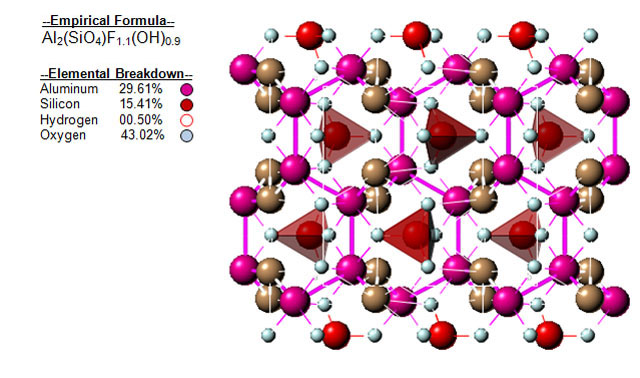
![]()
| Crystal System | Orthorhombic |  |
| Class | Dipyramidal | |
| Axial Ratios | a : b : c = 0.528 : 1 : 0.955 | |
| Morphology | Long to short prismatic | |
| Optical Data Type | Biaxial (+) | |
| Pleochroism (x) | Colourless | |
| Pleochroism (y) | Colourless | |
| RL Values | nα = 1.606 - 1.629 nβ = 1.609 - 1.631 nγ = 1.616 - 1.638 |  |
| 2V | Measured: 48° to 68°, Calculated: 58° to 68° | |
| Max Birefringence | δ = 0.010 (See colour chart at right) | |
| Surface Relief | Moderate | |
| Dispersion | Noticable r > v | |
| Notes: | Weak pleochroism can be observed in thin sections of topaz. |
![]()
Topaz can be referenced in certain current and historical texts under the following six names:
The mineral topaz can be translated into the following select languages:
| Arabic | زبرجد | Bulgarian | Топаз | Chinese (Sim) | 黄玉 |
| Croatian | Topaz | Czech | Topaz | Danish | Topas |
| Dutch | Topaas | Esperanto | Topaz | Estonian | Topaas |
| Finnish | Topaasi | French | Topaze | German | Topas |
| Greek | ουσ. τοπάζι | Hebrew | טופז | Hungarian | Topáz |
| Italian | Topazio | Japanese | トパーズ | Korean | 황옥 |
| Latin | Chrysolithus | Lithuanian | Topazas | Norwegian | Topas |
| Persian | زبرجد هندی | Polish | Topaz | Portuguese | Topázio |
| Romanian | Topaz | Russian | Топаз | Slovak | Topás |
| Spanish | Topacio | Swedish | Topas | Tagalog | Topasiyo |
| Turkish | Topaz | Ukrainian | Топаз | Vietnamese | hoàng ngọc |
![]()
Topaz can be found in many places around the world. The map below shows major documented concentrations of topaz:
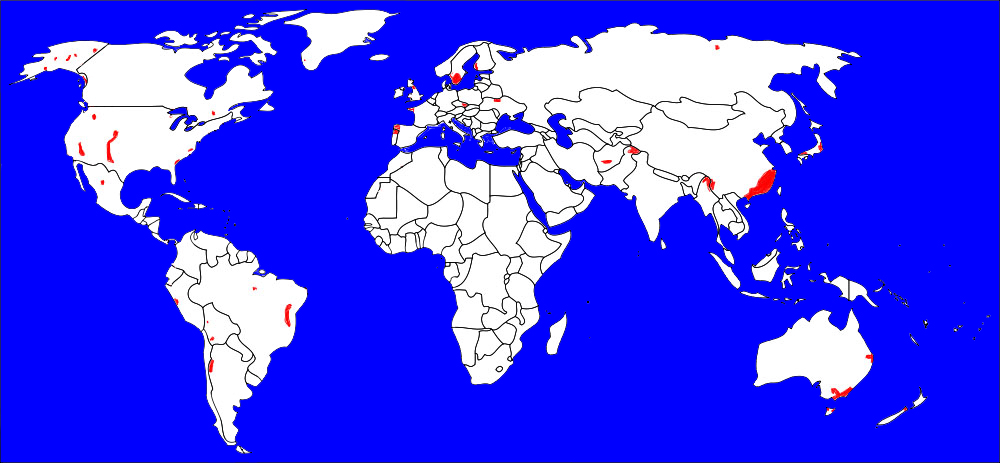
![]()
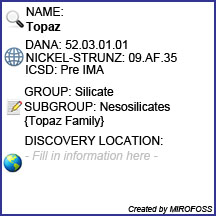 |
The MIROFOSS database offers free printable geological identification tags for personal and non-profit use. These tags can be used to properly identify mineral samples in your collection. -Click here- to download a full size jpeg image for a topaz identification tag; which can be printed on paper or used with a plastic laser printer. |
 |
What's this? What can I do with it? |
![]()
| Chemical Composition | Wunder B , Rubie D C , Ross C R , Medenbach O , Seifert F , Schreyer W , American Mineralogist , 78 (1993) p.285-297, Synthesis, stability, and properties of Al2SiO4(OH)2: A fully hydrated, analogue of topaz |
| Crystallography | E. E. Foord, L. L. Jackson, J. E. Taggart, J. G. Crock & T. V. V. King (1995): Topaz: environment of crystallization, crystal chemistry, and infrared spectra. Mineralogical Record, 26, 69–71. |
| History | Hurlbut, Cornelius S.; Klein, Cornelis, 1985, Manual of Mineralogy, 20th ed., ISBN 0-471-80580-7 |
| History | Famous and Notheworthy Topazes Rao Bahadur, A Handbook of Precious Stones, Geological Survey of India |
| Geographical Data | Mindat.org. Retrieved on 2012-01-05 |
| Physical Identification | Webmineral.com. Retrieved on 2012-01-05. |
| December 03, 2014 | The last time this page was updated |
| ©2017 MIROFOSS™ Foundation | |
 |
|


